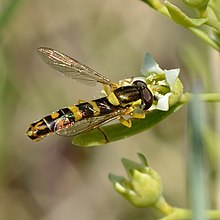Without a sheet of linen
| Without a sheet of linen | ||||||||||||
|---|---|---|---|---|---|---|---|---|---|---|---|---|

Before leaflet flax leaf ( Thesium ebracteatum ) |
||||||||||||
| Systematics | ||||||||||||
|
||||||||||||
| Scientific name | ||||||||||||
| Thesium ebracteatum | ||||||||||||
| Hayne |
The before-leaflet flax leaf ( Thesium ebracteatum ) is a species of plant that belongs to the sandalwood family (Santalaceae).
Description and ecology
Vegetative characteristics
The before-leaflet flax leaf is a deciduous, herbaceous , perennial plant that reaches heights of between 10 and 30 centimeters. It forms long, creeping rhizomes and runners . This semi-parasitic extracts nutrients from other plant species by means of suction organs in the root area.
Generative characteristics
The flowering period extends from May to June. The stems carry the racemose inflorescence and continue above the inflorescence with a flowerless tuft of leaves. The flowers appear together with only one bract , the bracts are missing. The perianth is five-fold.
The leathery fruit has a short stalk and, when ripe, is longer than the remaining flower shell. The seeds spread through ants.
The number of chromosomes is 2n = 24.
Occurrence
The main distribution of the before-leaflet flax leaf lies in Eastern Europe, in Eastern Central Europe and in Southeastern Europe, mainly between the 50th and 55th parallel . In the Baltic States, the before-leaflet Leinblatt reaches a northern outpost. To the east the Urals are reached, some deposits exist in the Asian part of Russia. In the west is the area boundary in Germany.
Overall, the flax-less flax leaf is very rare in Central Europe. In Central Europe , the before-leaflet Leinblatt colonizes heaths in the lowlands in areas with a favorable climate. The western border of the current closed distribution area is presumably in the southeast of Brandenburg and in the east of Saxony . To the west of it you can only find isolated individual locations. Since it grows almost exclusively on sandy soils that cannot be used for agricultural purposes, the main locations in the Lüneburg Heath , in the heaths near Itzehoe and Mölln, are likely to be preserved. In contrast, some locations west of the Elbe , which were still known at the beginning of the 20th century, were also destroyed by the intensification of agriculture, such as those in the Thuringian Basin around Erfurt .
The before- leaflet flax leaf thrives best on warm, acidic sandy soils . Warm summer locations are preferred. It usually grows in grass or heather areas , for example in silver grass corridors ( Corynephorion canescentis ) and acidic dry grasslands ( Koelerio-Phleion phleoides ), but also occurs in pine forests ( Cytiso-Pinion ).
Danger
In Germany only four sites are known, so it is listed on the 1996 Red List of Endangered Plant Species as threatened with extinction and is strictly protected under the Federal Species Protection Ordinance. Since it is rare and endangered in Europe as a whole, it is listed in the Appendix of the Bern Convention , as well as in Appendix II and IV of the Fauna-Flora-Habitat Directive .
swell
Individual evidence
- ↑ a b Henning Haeupler, Thomas Muer: picture atlas of the fern and flowering plants of Germany . Ed .: Federal Agency for Nature Conservation (= The fern and flowering plants of Germany . Volume 2 ). Eugen Ulmer, Stuttgart (Hohenheim) 2000, ISBN 3-8001-3364-4 , pp. 340 .
- ↑ a b c Thesium ebracteatum Hayne. (No longer available online.) Federal Agency for Nature Conservation, April 4, 2008, archived from the original on November 11, 2011 ; Retrieved October 24, 2009 . Info: The archive link was inserted automatically and has not yet been checked. Please check the original and archive link according to the instructions and then remove this notice.
- ↑ a b Erich Oberdorfer : Plant-sociological excursion flora . With the collaboration of Theo Müller. 7th, revised and expanded edition. Eugen Ulmer, Stuttgart (Hohenheim) 1994, ISBN 3-8252-1828-7 .
- ^ Erich Oberdorfer : Plant-sociological excursion flora for Germany and neighboring areas . 8th edition. Verlag Eugen Ulmer, Stuttgart 2001, ISBN 3-8001-3131-5 . Page 324.
- ↑ a b c d e Dietmar Aichele, Heinz-Werner Schwegler: The flowering plants of Central Europe . 2nd Edition. tape 3 : Evening primrose plants to reddish plants . Franckh-Kosmos, Stuttgart 2000, ISBN 3-440-08048-X .
- ↑ Jaakko Jalas, Juha Suominen (ed.): Atlas Florae Europaeae. Distribution of Vascular Plants in Europe. 3. Salicaceae to Balanophoraceae. Akateeminen Kirjakauppa, The Committee for Mapping the Flora of Europe & Societas Biologica Fennica Vanamo, Helsinki 1976, ISBN 951-9108-02-5 , p. 100.
Web links
- Without a sheet of linen. In: FloraWeb.de.
- Distribution map for Germany. In: Floraweb .
- Profile and distribution map for Bavaria . In: Botanical Information Hub of Bavaria .
- Data sheet with identification key from Thomas Meyer: Flora-de: Flora von Deutschland (old name of the website: Flowers in Swabia ).
- Data sheet with photos at Botanik im Bild / Flora von Österreich .
- Photos: [1] , [2] , [3]
